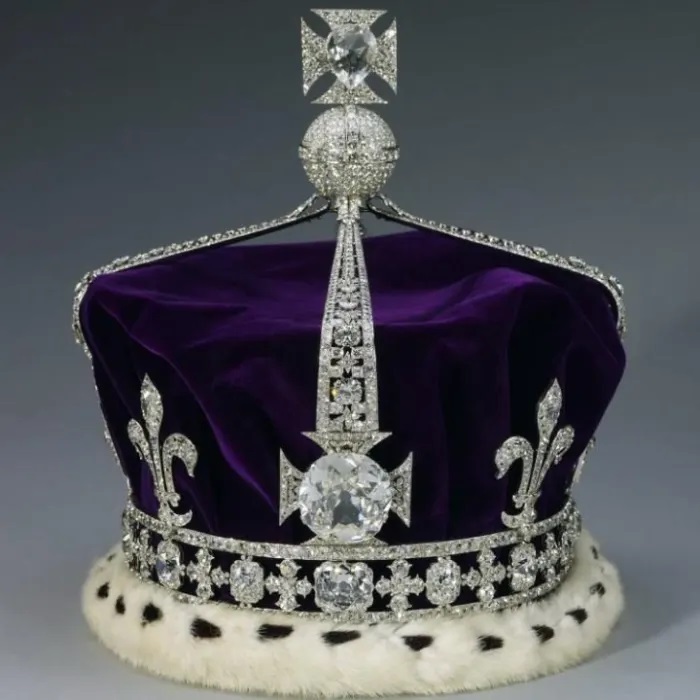Sanatan Articles
Satyaagrah
Written on
Satyaagrah
Written on
Satyaagrah
Written on
Satyaagrah
Written on
Satyaagrah
Written on
JOIN SATYAAGRAH SOCIAL MEDIA
Theft on a Grand Scale - Britain stole $45 Trillion from India and lied about it. Indian money developed Britain and Other Countries
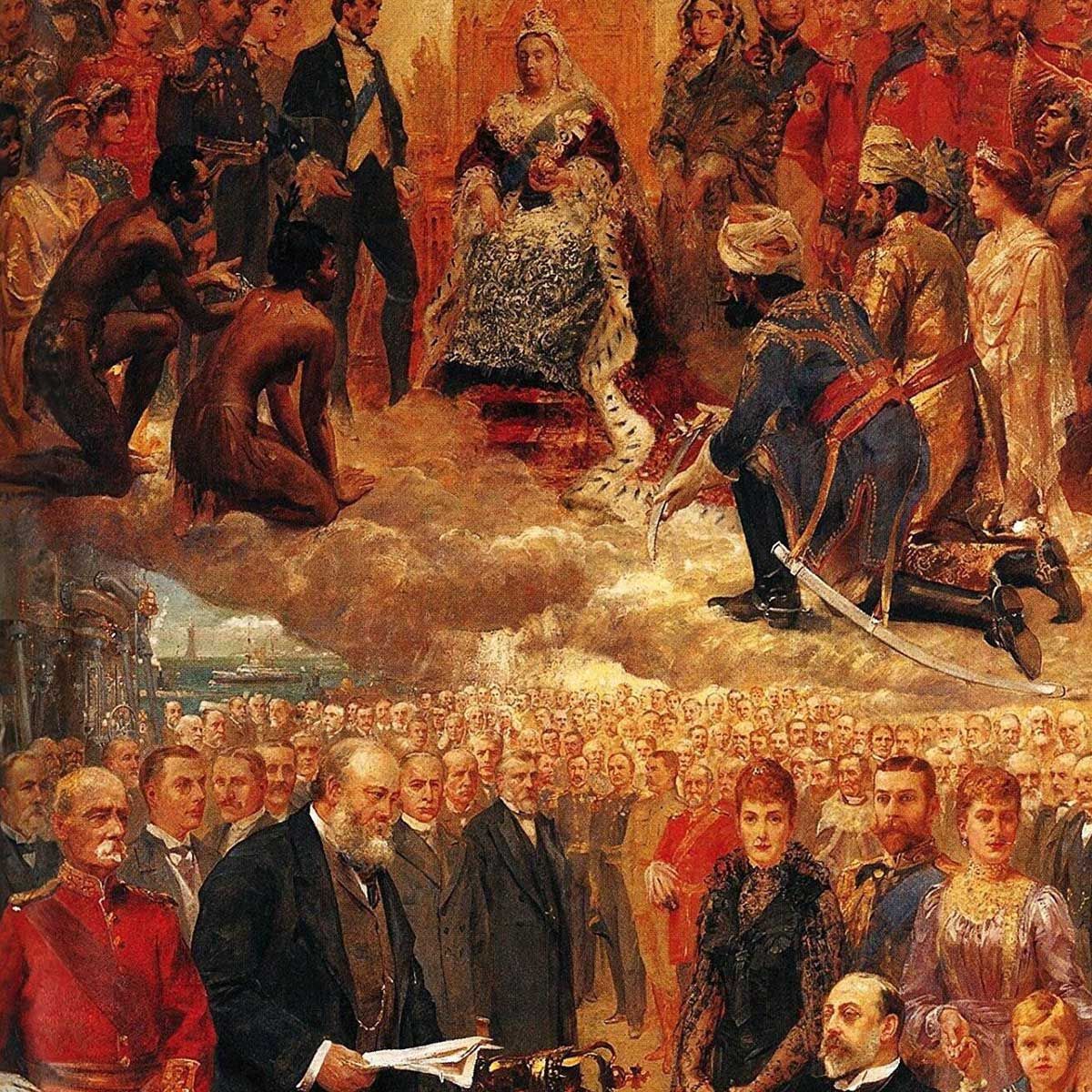
In this post, we’ll delve into the shadowy past of the British Empire and uncover how it contributed to the annihilation of numerous formerly prosperous nations, such as India. India was formerly termed as the “golden bird,” which was fairly accurate; at that time, India accounted for approximately 25% of global net wealth. India transitioned from a prosperous nation to a poor, impoverished one until the end of the British Raj in 1947.
There is a story that is commonly told in Britain that the colonisation of India – as horrible as it may have been – was not of any major economic benefit to Britain itself. If anything, the administration of India was a cost to Britain. So the fact that the empire was sustained for so long – the story goes – was a gesture of Britain’s benevolence.
 King George V and his wife Queen Mary (deferentially a step behind the monarch) in India in 1912. No doubt the Indian people were greatly impressed. |
Britain, on the other hand, continues to be unwilling to accept responsibility. According to a 2014 YouGov poll, over half of British citizens continue to feel colonization benefited colonies but harmed Britain. Historian Niall Ferguson and former British Prime Minister David Cameron endorsed this notion. They assert that colonizing India was unreasonably expensive, which is why Britain was compelled to make a big financial investment.
All of their assertions are based on a book titled White Man’s Burden. Based on this book, half of the British population still believe that Britain established colonies to transform an uncivilized society into a civilized society.
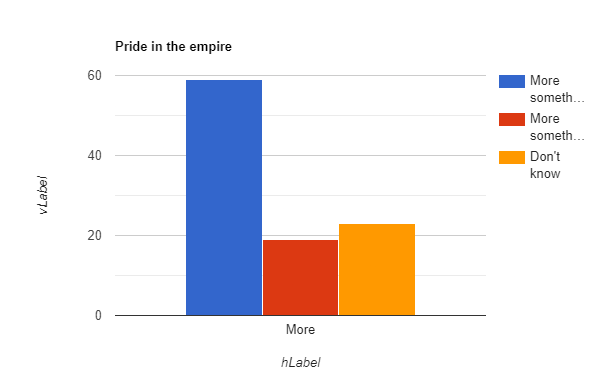 (Image source author data source YouGov) Pride in the empire — Is the British empire more something to be proud of? % — Blue-more something to be proud of, Red- More of something to be ashamed of, Yellow- Don’t know. |
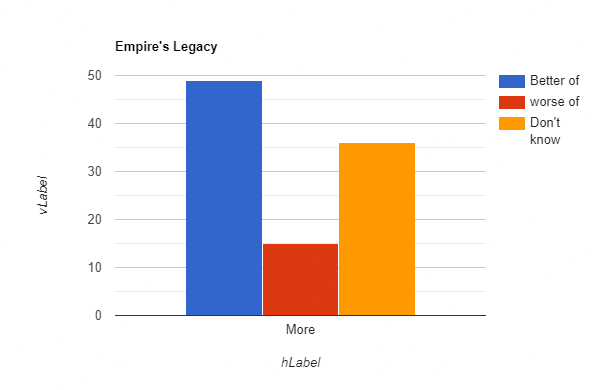 (Image source author data source YouGov) Question asked- Overall do you think the countries that were colonized by Britain are better of or worse of for being colonized? % |
In this post, we will examine Britain’s moral claim and we will also attempt to clarify Britain’s primary goal, which was to plunder and loot India.
Background
New research by the renowned economist Utsa Patnaik – just published by Columbia University Press – deals a crushing blow to this narrative. Drawing on nearly two centuries of detailed data on tax and trade, Patnaik calculated that Britain drained a total of nearly $45 trillion from India during the period 1765 to 1938.
It’s a staggering sum. For perspective, $45 trillion is 17 times more than the total annual gross domestic product of the United Kingdom today.
Later, India’s foreign affairs minister S.jaishankar took up the issue. Additionally, in 2015, former United Nations Under-Secretary-General Shashi Tharoor requested reparations from the UK government for this heist during an Oxford University lecture.
Subsequently, Shashi Tharoor wrote a book titled Inglorious Empire in which he detailed every instance of British plunder. He referred to former British Prime Minister Winston Churchill as one of the “worst genocidal dictators.” Additionally, he claimed Churchill was to blame for the deaths of thousands of Indian troops during WWII.
In 2015, Indian Prime Minister Modi lauded Shashi Tharoor and endorsed the reparations demand.
 The East India Company made a lot of money out of the opium trade causing impoverishment among the Indian farmers who grew poppies and death among the Chinese consumers. |
Exploitative Trade System
In the 1600s, the East India Company showed up in India and fought the Dutch and Portuguese; they landed in Surat in 1608. They subsequently began the construction of their factories. They initially established factories in major Indian coastal cities such as Surat, Bombay, Madras, Masulipatnam, and Bengal. These cities served as a trading centre for the East India Company.
At first, they used silver and gold to purchase textiles and rice from Indian producers and then sold them on the European market at a higher price. Initially, this trade benefited both the indigenous Indian market and the British.
However, the East India Company intended to do something else. After the victory in the battle of Buxar in 1764, the EIC acquired revenue collection rights in Bengal first, thereafter got it extended across the sub-continent systematically. Later, they used 1/3rd portion of the tax revenue to purchase goods, instead of investing it in India-This was the first loot.
Once they grasped revenue collection, they used revenue generated by Indian companies exclusively to purchase Indian goods, resulting in widespread exploitation of Indians. This was a scam; previously, they would purchase Indian goods in exchange for gold and silver; now, they are taking it for free and earning a 100% profit.
For a long time, Indian producers were unaware of this because the tax collection and goods production departments were administered by two distinct authorities.
The British used the massive profit gained by EIC to buy strategic raw materials such as Iron and timber to fuel their own industrial revolution back in Britain.
Thus, we may state categorically that Britain’s industrial revolution was predicated on the theft of the East India Company from India.
Apart from that, when the British monarchy officially acquired control of India in 1858, they abolished the EIC monopoly and permitted Indian producers to directly export their products. However, this was also a British ruse to confuse the Indians.
After EIC’s monopoly ended, Indian producers began exporting their products as well. However, rather than gold and silver, the British dealer used to pay Indian exporters in “Special Council Bills.” SCBs functioned similarly to checks, allowing Indian manufacturers to withdraw funds from colonial offices. However, British officers played a trick here by paying the money using funds collected from India’s tax revenue.
The objective of this policy was to prevent any outward flow of gold or other financial resources from Britain to India.
- According to UN data, India’s merchandise exports were the second highest in the world between 1900 to 1928, trailing only the United States. However, rather than becoming a trade surplus nation, India remained a trade deficit nation as a result of Britain’s dishonest and unethical policies.
Using this on paper deficit British economists claim that colonising India was detrimental for Britain.
 Lord Louis Mountbatten, the last Viceroy of India, and his wife, Lady Edwina Mountbatten, ride in the state carriage towards the Viceregal lodge in New Delhi, on March 22, 1947 |
Biased Trade Policy
Apart from organized looting, the British’s discriminatory trade policies contributed to the De-industrialization of the Indian economy. India’s textile industry suffered significantly as a result of this policy.
The Indian textile industry thrived till the late 17th century. Demand for Indian handwoven textiles was quite strong around the world, including the United Kingdom. However, as a result of the industrial revolution in the United Kingdom, they can now make cheaper machine-made clothing.
To promote British clothing, Britain put high tariffs on imported Indian textiles, effectively rendering them uncompetitive in the UK in comparison to British clothing.
As a result of the Indian textile industry’s inability to compete, low-cost machine-made clothes arrived in the country, reducing demand for domestic handloom clothes and eventually resulted in the downfall of the Indian textile industry.
The unfair trade practice of Britain destroyed the Indian traditional textile sector and caused the ‘De-industrialization’ of the Indian economy. De-industrialization not only destroyed the Indian economy but also placed a heavy load on the previously saturated agricultural industry.
Indian Resources to Finance War
Britain used Indian revenues to accomplish colonial ambitions rather than using them for Indian development. For instance, in the 1840s, Britain utilized Indian money to finance China’s invasion campaign, and also to suppress the Indian rebellion in 1857.
According to Ustasav Patnaik, ‘almost every battle that Britain waged after colonizing India, was financed by Indian taxpayers.’ Additionally, they exploited the revenue gained from India to expand their capitalist agenda in Europe, Canada, and Australia.
Thus, we can state unequivocally that the industrialisation of the western world was dependent on money looted from India.
The economic drain of $45 trillion from India to Britain is merely an ‘Indicative amount,’ since it does not account for the British’s rampant exploitation of India’s human resources through the use of ‘Indentured labourers.’
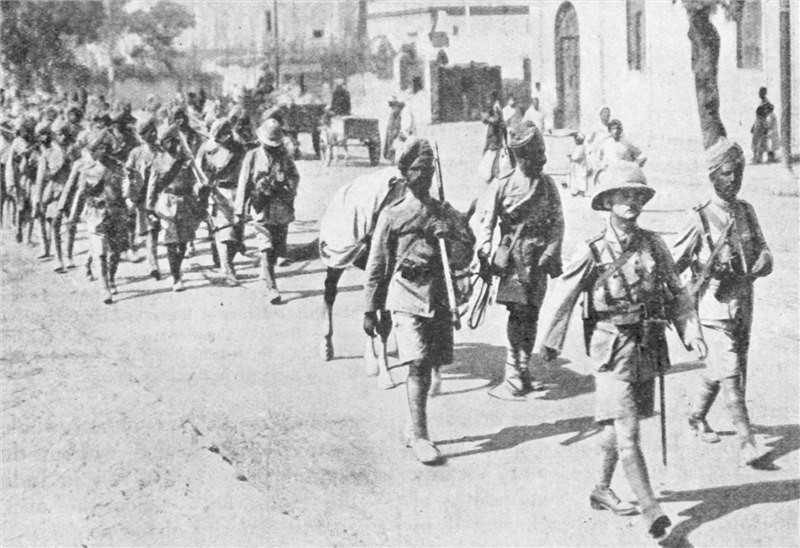 (Attribution: Unknown author, Public domain, via Wikimedia Commons) Indian forces on their way to the Front in Flanders — first world war |
The British also sent Indian troops to fight on the Allied side during WWI and WWII. Indian soldiers had no desire to fight in this war but were compelled to do so by the British monarch.
According to Sashi Tharoor, approximately one-sixth of British soldiers were of Indian origin, and nearly 54,000 Indian soldiers were killed in action during WWI alone. The total cost of India’s coerced support for Britain during World War II has been estimated at £100 million.
Trade Deficit
The British economist asserts British losses based on a fictitious ‘paper-trade deficit.’ As I mentioned previously, this on-paper deficit benefited Britain on the ground because they received free Indian goods and made a 100% profit.
De-Industrialization of Indian Economy
British historians also assert that the Indian economy was already deindustrializing before the arrival of the British, owing to the decline of the Mughal empire.
The theory of ‘pre-industrialization of the Indian economy’ is partially correct. However, it is also true that the British hastened the process further through their exploitative and unethical trade policies.
Additionally, the Britishers can’t explain how India became a trade ‘deficit’ country despite having the world’s second-largest merchandise export.
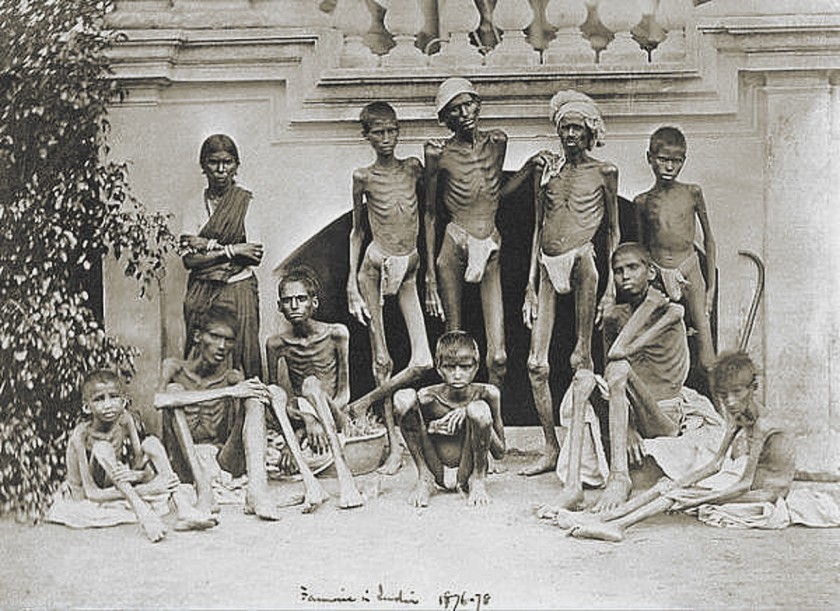 The Bengal famine of 1943, 3 million Indians died while British loot continued |
Introduction of Moder Education
The third argument advanced by British apologists is that the British were instrumental in India’s development by introducing modern education, railways, the postal system, and a modern bureaucracy. This was really beneficial to India.
However, because India was the richest colony, the British needed to improve communication and establish a proper bureaucratic system to fully exploit its potential. Given that these were introduced primarily to advance ‘British Interests’ and not India’s development agenda, the British cannot claim a moral victory.
The British introduced modern education in response to the need for people with western education in the British bureaucracy. The primary objective of education was to produce lower-level clerks.
What Lies Ahead
The British monarchy asserted that they colonized India to develop it. However, during the entire 200-year period of British colonialism, the Indian economy continued to contract. In the second half of the nineteenth century, India’s national income nearly halved. Between 1870 and 1920, the average life expectancy decreased by a fifth.
British policy also resulted in multiple massive famine in India, the most severe of which was the Bengal famine of 1943, which killed nearly 3 million people.
If India, like Japan, had been able to invest its own tax revenues and foreign exchange earnings in development, who knows how history might have turned out differently. India could have developed into a global power, averting centuries of pain and suffering.
What does this require of Britain today? An apology? Absolutely. Reparations? Perhaps – although there is not enough money in all of Britain to cover the sums that Patnaik identifies. In the meantime, we can start by setting the story straight. We need to recognise that Britain retained control of India not out of benevolence but for the sake of plunder and that Britain’s industrial rise didn’t emerge sui generis from the steam engine and strong institutions, as our schoolbooks would have it, but depended on violent theft from other lands and other peoples.
Britain didn’t develop India. On the contrary, as Patnaik’s work demonstrates, India contributed to the development of Britain.
Bonus Factoids
- While Britain allegedly made off with much of India's wealth it also lifted some of its language; “loot” is a Hindi word meaning “plunder.”
- There are more Indian restaurants in London, England than there are in New Delhi or Mumbai.
- At the 1928 Olympics in Amsterdam, the Indian field hockey team was so good that the British team withdrew from the competition to avoid what they saw might be an embarrassing defeat at the hands of a colony.
- The Koh-i-Noor, at 108.9 carats, is one of the world's largest diamonds. In 1849, the British defeated the Sikhs in a war and part of the peace treaty required that the Maharajah of Lahore “surrender” the Koh-i-Noor diamond to the Queen of England. The British interpret the word “surrender” to mean “gifted,” to most Indians the word means “stolen.” The diamond, with an estimated value of $200 million, is part of the British Crown Jewels and is mounted on The Queen Mother's Crown.

The Koh-i-Noor diamond on the front is one of 2,800 other diamonds on the Queen Mother's Crown.
References:
cadtm.org
historyofyesterday.com
kreately.in
“The East India Company: The Original Corporate Raiders.” William Dalrymple, The Guardian, March 4, 2015
“British India to 1857: The Rise and Fall of the East India Company.” Tom Williams, English Historical Fiction Authors, October 1, 2013
“How Britain Stole $45 Trillion from India.” Jason Hickel, Al Jazeera, December 19, 2018
“Press Briefing Given by Prime Minister David Cameron in Amritsar.” U.K. Government, February 21, 2013
“The Great Loot: How Britain Stole $45 Trillion from India.” Aroonim Bhuyan and Capt. Krishnan Sharma, India Post News Service, October 30, 2019
“The British Empire Is 'Something to Be Proud of.' ” Will Dahlgreen, YouGov, July 26, 2014.
 Support Us
Support Us
Satyagraha was born from the heart of our land, with an undying aim to unveil the true essence of Bharat. It seeks to illuminate the hidden tales of our valiant freedom fighters and the rich chronicles that haven't yet sung their complete melody in the mainstream.
While platforms like NDTV and 'The Wire' effortlessly garner funds under the banner of safeguarding democracy, we at Satyagraha walk a different path. Our strength and resonance come from you. In this journey to weave a stronger Bharat, every little contribution amplifies our voice. Let's come together, contribute as you can, and champion the true spirit of our nation.
 |  |  |
| ICICI Bank of Satyaagrah | Razorpay Bank of Satyaagrah | PayPal Bank of Satyaagrah - For International Payments |
If all above doesn't work, then try the LINK below:
Please share the article on other platforms
DISCLAIMER: The author is solely responsible for the views expressed in this article. The author carries the responsibility for citing and/or licensing of images utilized within the text. The website also frequently uses non-commercial images for representational purposes only in line with the article. We are not responsible for the authenticity of such images. If some images have a copyright issue, we request the person/entity to contact us at This email address is being protected from spambots. You need JavaScript enabled to view it. and we will take the necessary actions to resolve the issue.
Related Articles
- Our first true war of independence lie forgotten within the fog of time and tomes of propaganda: Sanyasi Rebellion, when "renouncers of the material world" lead peasants in revolt against British and fundamentalist islamic clans
- Madras High Court: Do not take decision on melting Temple gold till Trustees are appointed
- Was Italian family of Sonia Gandhi involved in the Bofors scam: Papers long buried, questions that were never asked
- Oops… NCERT did it again: A predictable textbook case of Indian history howlers
- An Artisan Heritage Crafts Village: Indigenous Sustainability of Raghurajpur
- Vinayak Damodar Savarkar – A Misunderstood Legacy
- Depth of Soviet penetration in Indian media is exposed through declassified CIA document from 2011
- Santi Ghosh and Suniti Choudhury: Two Teenage Freedom Fighters Assassinated British Magistrate
- A Great man Beyond Criticism - Martyrdom of Shaheed Bhagat Singh (Some Hidden Facts)
- Pt. Madan Mohan Malaviya’s independent ‘Note’ to the Industrial Commission of 1916: India’s Industrial Heritage
- Wikileaks and 5 lesser know facts of Indira Gandhi: Nuclear technology, corruption and foreign relations
- Father of the Nation! Absolutely not. Mohandas Karamchand Gandhi was not the father of the nation either officially or otherwise
- NCERT turns woke with sex-interested contributor Vikramaditya Sahai pushing gender jargon on children: How LGBT activists are calling legitimate criticism of a public figure ‘transphobia’
- Nehru's Himalayan Blunders which costed India dearly - Integration of Princely States
- Toxic Western ideologies being pushed into Indian schools via promoting LGBT and gender politics propaganda among children












